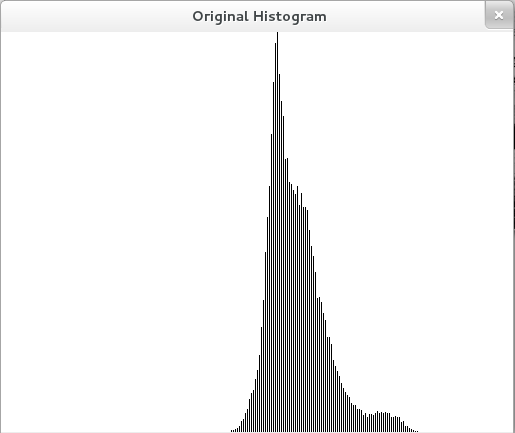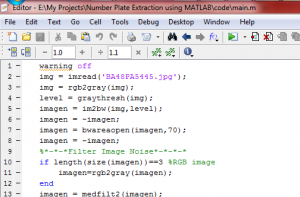Histogram equalization using C++: Image Processing
Theory
The histogram equalization is an approach to enhance a given image. The approach is to design a transformation T such that the gray values in the output are uniformly distributed in [0, 1].
Algorithm
Compute a scaling factor, α= 255 / number of pixels
Calculate histogram of the image
Create a look-up table LUT with
LUT[0] = α * histogram[0]
for all remaining grey levels, i, do
LUT[i] = LUT[i-1] + α * histogram[i]
end for
for all pixel coordinates, x and y, do
g(x, y) = LUT[f(x, y)]
end for
#include <iostream>
#include <opencv2/highgui/highgui.hpp>
#include <opencv2/imgproc/imgproc.hpp>
using std::cout;
using std::cin;
using std::endl;
using namespace cv;
void imhist(Mat image, int histogram[])
{
// initialize all intensity values to 0
for(int i = 0; i < 256; i++)
{
histogram[i] = 0;
}
// calculate the no of pixels for each intensity values
for(int y = 0; y < image.rows; y++)
for(int x = 0; x < image.cols; x++)
histogram[(int)image.at<uchar>(y,x)]++;
}
void cumhist(int histogram[], int cumhistogram[])
{
cumhistogram[0] = histogram[0];
for(int i = 1; i < 256; i++)
{
cumhistogram[i] = histogram[i] + cumhistogram[i-1];
}
}
void histDisplay(int histogram[], const char* name)
{
int hist[256];
for(int i = 0; i < 256; i++)
{
hist[i]=histogram[i];
}
// draw the histograms
int hist_w = 512; int hist_h = 400;
int bin_w = cvRound((double) hist_w/256);
Mat histImage(hist_h, hist_w, CV_8UC1, Scalar(255, 255, 255));
// find the maximum intensity element from histogram
int max = hist[0];
for(int i = 1; i < 256; i++){
if(max < hist[i]){
max = hist[i];
}
}
// normalize the histogram between 0 and histImage.rows
for(int i = 0; i < 256; i++){
hist[i] = ((double)hist[i]/max)*histImage.rows;
}
// draw the intensity line for histogram
for(int i = 0; i < 256; i++)
{
line(histImage, Point(bin_w*(i), hist_h),
Point(bin_w*(i), hist_h - hist[i]),
Scalar(0,0,0), 1, 8, 0);
}
// display histogram
namedWindow(name, CV_WINDOW_AUTOSIZE);
imshow(name, histImage);
}
int main()
{
// Load the image
Mat image = imread("scene.jpg", CV_LOAD_IMAGE_GRAYSCALE);
// Generate the histogram
int histogram[256];
imhist(image, histogram);
// Caluculate the size of image
int size = image.rows * image.cols;
float alpha = 255.0/size;
// Calculate the probability of each intensity
float PrRk[256];
for(int i = 0; i < 256; i++)
{
PrRk[i] = (double)histogram[i] / size;
}
// Generate cumulative frequency histogram
int cumhistogram[256];
cumhist(histogram,cumhistogram );
// Scale the histogram
int Sk[256];
for(int i = 0; i < 256; i++)
{
Sk[i] = cvRound((double)cumhistogram[i] * alpha);
}
// Generate the equlized histogram
float PsSk[256];
for(int i = 0; i < 256; i++)
{
PsSk[i] = 0;
}
for(int i = 0; i < 256; i++)
{
PsSk[Sk[i]] += PrRk[i];
}
int final[256];
for(int i = 0; i < 256; i++)
final[i] = cvRound(PsSk[i]*255);
// Generate the equlized image
Mat new_image = image.clone();
for(int y = 0; y < image.rows; y++)
for(int x = 0; x < image.cols; x++)
new_image.at<uchar>(y,x) = saturate_cast<uchar>(Sk[image.at<uchar>(y,x)]);
// Display the original Image
namedWindow("Original Image");
imshow("Original Image", image);
// Display the original Histogram
histDisplay(histogram, "Original Histogram");
// Display equilized image
namedWindow("Equilized Image");
imshow("Equilized Image",new_image);
// Display the equilzed histogram
histDisplay(final, "Equilized Histogram");
waitKey();
return 0;
}Note: OpenCV is used for read and display image only.
Output
Original Image and Histogram
Equalized Image and Histogram








Thanks
Thank you!
i have some problems with visual studio 2013 , please help , anybody ?
actually you use opencv too in:
histogram[(int)image.at(y,x)]++;
This comment has been removed by the author.
i have a question. In my case equalize image is only about one third of the mine, and the remaining two thirds of the original image appears I don't know what is wrong.
Thank you very much!
Is there a mistak at the line 126
I think it should be:
final[i] = cvRound(PsSk[i] * 255.0 * 255.0);
can i call this as , the algorithm of histogram equalization ,which is working on grayscale image and single channel of colour image?
if not,I need a coding for this particular thing
can i say this is the answer for, implementation of algorithm of histogram equalization which works on grayscale image and single channel of color image.
if not,i would like to get an answer for this please
am using Code::BLocks and it isnt running
Thanks …
You have to install OpenCV in code::block first..Hop this helps